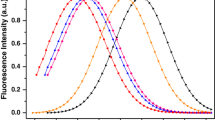Abstract
The fluorescence characteristics of five hydroxiflavones (HFs) (some typical models of flavonols), (3 - HF, 6 - HF, 7-HF, 3, 6 - diHF and 3, 7-diHF) in the micellar media of non-ionic surfactant (Triton X-100), anionic surfactant (SDS) and the block copolymer Pluronic F127, have been investigated by means of UV–Vis and steady-state and time resolved fluorescence spectroscopies. Attention is paid to both excited-state intra-molecular proton transfer (ESIPT) as well as ground-state intermolecular proton transfer. The influence of the -OH groups as well as the effect of temperature on the dual fluorescence emission, the Normal and Tautomer emissions, are also investigated. The fluorescence quantum yield of the HFs in mentioned micellar media has been also determined. The results are discussed with relevance to the local environment of HFs as sensitive fluorescence probe in biological membrane systems.






Similar content being viewed by others
References
Sengupta PK, Kasha M (1979) Exited state proton- transfer spectroscopy of 3-hydroxyflavone and quercetin. Chem Phys Lett 68:382–385
Guharay J, Sengupta B, Sengupta PK (2001) Protein-flavonol interaction: fluorescence spectroscopy study. Proteins 43:75–81
McMorrow D, Kasha M (1984) Intramolecular excited state proton transfer in 3-hydroxiflavone, hydrogen—bonding, solvent perturbation. J Phys Chem 88:2235–2243
Strandjord AJG, Courtney SH, Friedrich DM, Barbara PF (1983) Excited state dynamics of 3-hydroxyflavone. J Mc Phys Chem 87:1125–1133
Quaranta A, Carturan S, Maggioni G, Ceccato R, Della Mea G (2003) Probing the chemical environment of 3-hydroxyflavone doped ormosils by a spectroscopic study of excited state intramolecular proton transfer. J Non-Cryst Solids 322:1–6
Shyamala T, Mishra AK (2004) Ground- and excited-state proton transfer reaction of 3-Hydroxyflavone in dimyristoylphosphatidylcholine liposome membrane. J Photochem Photobiol 80:309–315
Shynkar VV, Klymchenko AS, Kunzelmann C, Duportail G, Muller CD, Demchenko AP, Freyssinet J-M, Mely Y (2007) Fluorescent biomembrane probe for ratiometric detection of apoptosis. J Am Chem Soc 129:2187–2193
Shvadehak VV, Klymchenko AS, De Rocquigny H, Mely Y (2009) Sensing peptide-oligonucleotide interactions by a two-color fluorescence label: applications to the HIV-1 nucleocapsid protein. Nucleic Acids Res 37:e25
Wolfbeis OS, Shulman SG (Ed.) (1985) Molecular luminescence spectroscopy: Methods and applications Part –I, Wiley, New York
Sengupta B, Guharay J, Sengupta PK (1998) Reverse micelles of TX-100 in mixed solvents of benzene and n-hexane: fluorescence studies using 7-hydroxiflavone as probe. J Surf Sci Technol 14:150–156
Dennison SM, Guharay J, Sengupta PK (1999) Intramolecular excited proton—transfer and charge transfer fluorescence of a 3-hydroxiflavone derivative in micellar media. Spectrochim Acta, Part A 55:903–909
Dennison SM, Guharay J, Sengupta PK (1999) Excited-state intramolecular proton transfer (ESIPT) and charge transfer (CT) fluorescence probe for model membranes. Spectrochim Acta, Part A 55:1127–1132
Guharay J, Dennison SM, Sengupta PK (1999) Influence of different environments on the excited—state proton transfer and dual fluorescence of fisetin. Spectrochim Acta, Part A 55:1091–1099
Kasha M (1987) Proton transfer spectroscopy and proton transfer lasers. Acta Phys Pol, A 71:717–729
Itoh M, Adachi T (1984) Transient absorption and two-step laser excitation fluorescence studies of the excited-state proton transfer and relaxation in the methanol solution of 7- hydroxyflavone. J Am Chem Soc 106:4320–4324
Sarkar M, Sengupta PK (1991) Influence of different micellar environments on teh excited-state proton transfer luminescence of 3-hydroxiflavone. Chem Phys Lett 179:68–72
Sarkar M, Ray GJ, Sengupta KP (1996) Effect of reverse micelles on the intramolecular excited state transfer (ESPT) and dual luminescence behavior of 3-hydroxiflavone. Spectrochim Acta A 52:275–278
Sarkar M, Ray GJ, Sengupta KP (1996) Luminescence behaviour of 7-hydroxyflavone in aerosol OT reverse micelles: excited-state proton transfer and red-edge excitation effects. J Photochem Photobiol 95:157–160
Kasha M (1986) Proton-transfer spectroscopy: perturbation of tautomeric potential. J Chem Soc, Faraday Trans 82:2379–2392
Klymchenko AS, Demchenko AP (2002) Probing AOT reverse micelles with two-color fluorescence dyes based on 3-hydroxychromone. Langmuir 18:5637–5639
Guharay J, Chaudhuri R, Chakrabarti A, Sengupta PK (1997) Excited state proton transfer fluorescence of 3-hydroxyflavone in model membranes. Spectrochim Acta A 53:457–462
Mondal S, Basu S, Mandal D (2009) Ground –and excited-state proton-transfer reaction of 3-hydroxyflavone in aqueous micelles. Chem Phys Lett 479:218–223
Demchenko AP, Klymchenko AS, Pivovarenko VG, Ercelen S, Duportail G, Mely Y (2003) Multiparametric color-changing fluorescence probes. J Fluoresc 13:291–295
Basu S, Mondal S, Mandal D (2010) Proton transfer reactions in nanoscopic polar domains:3-hydroxyflavone in AOT reverse micelles. J Chem Phys 132:034701–1/6
Voicescu M, Ionescu S, Gatea F (2013) Photophysical properties of some flavone probes in homogeneous media. J Fluoresc. doi:10.1007/s10895-013-1272-0
Melhuish WH (1961) Quantum efficiencies of fluorescence of organic substances: effect of solvent and concentration of the fluorescent solute. J Phys Chem 65:229–235
Lakowicz JR (1983) Principles of fluorescence spectroscopy. Plenum Press, New York
Acknowledgments
This work was supported by a grant of the Romanian National Authority for Scientific Research, CNCS – UEFISCDI, project number PN-II-RU-TE-2012-3-0055.
Author information
Authors and Affiliations
Corresponding author
Rights and permissions
About this article
Cite this article
Voicescu, M., Ionescu, S. Fluorescence Characteristics of some Flavones Probes in Different Micellar Media. J Fluoresc 24, 735–743 (2014). https://doi.org/10.1007/s10895-013-1346-z
Received:
Accepted:
Published:
Issue Date:
DOI: https://doi.org/10.1007/s10895-013-1346-z




